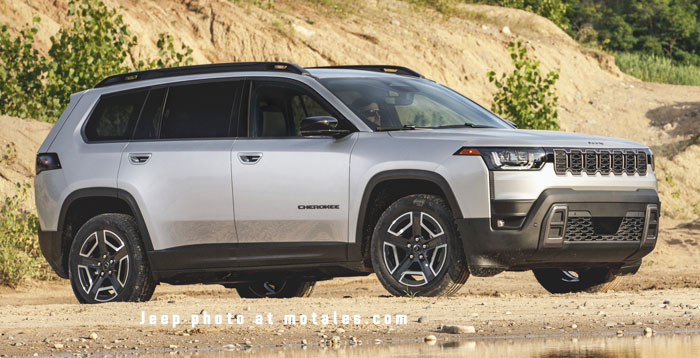The 2026 Jeep Cherokee (“KM”) has been officially released, confirming some rumors and denying others. The first rumor to go was the belief that the Cherokee would use a Punch Powertrain (DAF) DT2 dual wet clutch transmission; instead, like the KL Cherokee it replaces, the KM will use a CVT.  US prices of $36,995 were confirmed, with each trim going up by $3,000, and a destination charge of $2,000. The base model is equipped like a high end model of most cars, though, so the prices aren’t directly comparable to, say, the RAV4. In Canada, the starting price is $42,390 (CAD), including destination and fees; Laredo and Overland each add $5,000, then Limited adds $4,000. All Cherokees are made in Toluca, Mexico. The price seems high, but every Cherokee is large and loaded with features—with a 12.3 inch high-resolution center screen and 10.25 inch gauge cluster display. The car has wireless phone control (CarPlay/Auto); rain-sensing wipers; active cruise control and lane keeping; and blind spot monitoring with rear cross path detection and intersection collision alerts. Comparing apples to apples, it’s reasonably priced.
US prices of $36,995 were confirmed, with each trim going up by $3,000, and a destination charge of $2,000. The base model is equipped like a high end model of most cars, though, so the prices aren’t directly comparable to, say, the RAV4. In Canada, the starting price is $42,390 (CAD), including destination and fees; Laredo and Overland each add $5,000, then Limited adds $4,000. All Cherokees are made in Toluca, Mexico. The price seems high, but every Cherokee is large and loaded with features—with a 12.3 inch high-resolution center screen and 10.25 inch gauge cluster display. The car has wireless phone control (CarPlay/Auto); rain-sensing wipers; active cruise control and lane keeping; and blind spot monitoring with rear cross path detection and intersection collision alerts. Comparing apples to apples, it’s reasonably priced.  The company claims best in class off-road numbers, but the approach, departure, and breakover angles are similar to the prior-generation Cherokee, and they have similar ground clearance. All wheel drive is standard, rather than optional as it was before. It’s not impossible that the Trail Rated can match or beat the KL, which would imply the ability to tackle the Rubicon—somewhat harder with the wider KM. Neither comes close to the classic XJ approach, departure, or breakover angles or running ground clearance. Its drag coefficient (cD) of 0.335 is oddly high for 2026; the Cherokee has a CdA of 9.7 square feet. Combined leg room is 79.8 inches, according to the specifications sheet, which is around 1.6 inches less than the prior-generation front-drive Cherokees, and almost the same as the classic XJ Cherokee. The battery is a 400V system though this isn’t especially important since it charges from the onboard generator or regenerative braking. We now know that the climate control is electrical (heat pump) to stay active when on battery. There are two motor/generators, one of which doubles as a starter. The Cherokee can run up to 62 mph (100 km/h) on battery only, for short lengths of time.
The company claims best in class off-road numbers, but the approach, departure, and breakover angles are similar to the prior-generation Cherokee, and they have similar ground clearance. All wheel drive is standard, rather than optional as it was before. It’s not impossible that the Trail Rated can match or beat the KL, which would imply the ability to tackle the Rubicon—somewhat harder with the wider KM. Neither comes close to the classic XJ approach, departure, or breakover angles or running ground clearance. Its drag coefficient (cD) of 0.335 is oddly high for 2026; the Cherokee has a CdA of 9.7 square feet. Combined leg room is 79.8 inches, according to the specifications sheet, which is around 1.6 inches less than the prior-generation front-drive Cherokees, and almost the same as the classic XJ Cherokee. The battery is a 400V system though this isn’t especially important since it charges from the onboard generator or regenerative braking. We now know that the climate control is electrical (heat pump) to stay active when on battery. There are two motor/generators, one of which doubles as a starter. The Cherokee can run up to 62 mph (100 km/h) on battery only, for short lengths of time.  The engine runs on the Miller cycle, with 177 hp and 221 lb-ft of torque, the latter from 2,000 to 3,500 rpm. Compression is a high 11.3:1. The turbocharger, active up to 38 psi, is accompanied by an intercooler (really, a liquid charge air cooler). Direct injection completes the package. Overall, nearly all the rumors and projections turned out to be accurate. The transmission is a CVT, no doubt using Active Drive work from the past Cherokee; the interior seems smaller than expected; a foot-wave-activated power hatch is optional; and the car is much more “loaded” than expected, keeping more of the Wagoneer S than one would have thought. Offroad specs are probably better than anticipated, though the real proof will come with the trail rated model. The power and economy are as slipped the other day. Nobody was guessing weight, but being 4,295 pounds is not surprising—more than the KL, less than the battery-laden Wagoneer S. Getting 44 mpg (city) with this weight is a nice feat. Full information is on our sister site’s permanent 2026 Jeep Cherokee page.
The engine runs on the Miller cycle, with 177 hp and 221 lb-ft of torque, the latter from 2,000 to 3,500 rpm. Compression is a high 11.3:1. The turbocharger, active up to 38 psi, is accompanied by an intercooler (really, a liquid charge air cooler). Direct injection completes the package. Overall, nearly all the rumors and projections turned out to be accurate. The transmission is a CVT, no doubt using Active Drive work from the past Cherokee; the interior seems smaller than expected; a foot-wave-activated power hatch is optional; and the car is much more “loaded” than expected, keeping more of the Wagoneer S than one would have thought. Offroad specs are probably better than anticipated, though the real proof will come with the trail rated model. The power and economy are as slipped the other day. Nobody was guessing weight, but being 4,295 pounds is not surprising—more than the KL, less than the battery-laden Wagoneer S. Getting 44 mpg (city) with this weight is a nice feat. Full information is on our sister site’s permanent 2026 Jeep Cherokee page.

David Zatz started what was to become the world’s biggest Mopar site (Allpar) in 1994. After a chemo-induced 2007-2010 break, during which he wrote car books covering Vipers, minivans, and Jeeps, he returned with Patrick Rall to create StellPower.com for daily news, and to set up MoTales for mo’ tales (Chrysler history and “permanent” car and truck pages). He most recently wrote Century of Chrysler, a 100-year retrospective on the marque.
Discover more from Stellpower - that Mopar news site
Subscribe to get the latest posts sent to your email.